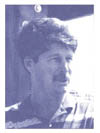Recipients
Award Categories Block
Years
Awardee
 The single awardee in the nonprofit category, Gary Gorman is the founder and Executive Director of the Huntington Beach Wetlands Conservancy, a small, nonprofit land trust dedicated to protecting and enhancing California’s Huntington Beach wetlands. Through the Conservancy, Gary has organized local support for the area’s wetlands, mobilized the city government, obtained funding, acquired property, prepared an enhancement plan, coordinated mitigation activities involving ten different public agencies, and restored the marsh.
The single awardee in the nonprofit category, Gary Gorman is the founder and Executive Director of the Huntington Beach Wetlands Conservancy, a small, nonprofit land trust dedicated to protecting and enhancing California’s Huntington Beach wetlands. Through the Conservancy, Gary has organized local support for the area’s wetlands, mobilized the city government, obtained funding, acquired property, prepared an enhancement plan, coordinated mitigation activities involving ten different public agencies, and restored the marsh.
The Huntington Beach Wetlands are located in Orange County, California, near the mouth of the Santa Ana River. The wetlands once occupied nearly 3,000 acres, but by 1984, due to channelization of the river, draining of the wetlands, and urban development, they had shrunk to 147 acres. Even in its present state, the area is a prime habitat for the endangered Belding’s Savannah Sparrow and is home to 15 percent of that species’ Orange County breeding population. These remaining wetlands might also have been lost if not for Gary’s efforts.
When Gary moved with his family to Huntington Beach in 1978, he was told by a realtor that the vacant lot between his house and the ocean was a state reserve. It was not. The property was in the hands of several private and public owners. The undeveloped area stretched between the Santa Ana River mouth and Highway 39, bordered by highway, housing developments, and light industry. In the summer, beachgoers parked their cars there, filling the air with dust and leaving behind mounds of trash and litter.
When Gary inquired into the status of the property in 1984, he found that it was not just any vacant lot, it was wetlands, and formerly the Santa Ana River bottom. In an effort to protect the area, he enlisted the aid of another Huntington Beach group—the Amigos de Bolsa Chica—who were working to save a larger wetland area on the other side of town. Too busy with their battle to fight his, they told Gary how to set up his own citizen action group. And he did. That same year, Gary formed the Friends of the Huntington Beach Wetlands, and the fight was on. Membership grew from a few of Gary’s neighbors to a small but vocal army of 150. Their first victory was convincing the city to fence off the area. With the impact of cars removed, the native vegetation, including pickleweed and salt grass, began to return.
In 1985, Gary learned from the California State Coastal Conservancy that a 25-acre parcel of the Huntington Beach wetlands, owned in part by the California Department of Transportation, was available for restoration. The Coastal Conservancy asked Gary if his organization would like to participate in restoring the area. Responding with enthusiasm, Gary and several active members of the Friends formed the Huntington Beach Wetlands Conservancy, a nonprofit land trust with a seven-member board of directors, which he chaired.
The first task of the Conservancy was to obtain funding and prepare an enhancement plan for the area, which they named Talbert Marsh. They decided to contour the 25-acre parcel to provide upland, high salt marsh, low salt marsh, mudflat and open water habitats. Restoration would include removing a dike that separated the Talbert Flood control channel from the degraded wetlands to provide improved flood control for local citizens and an enhanced habitat for endangered species, such as the Belding’s Savannah Sparrow and the California Least Tern.
To acquire the property, restore the marsh, and coordinate mitigation activities, Gary entered into a series of negotiations involving 10 different federal, state, and local agencies. Under the two interagency agreements he coordinated, the restoration of the Talbert Marsh would be counted as mitigation for several separate projects: improvements to the Orange County Flood Control system involving both federal and county agencies; improvements for the county Sanitation District; widening of the Pacific Coast Highway by the state; and widening of the Brookhurst Street Bridge by the city.
The negotiations were highly successful. Three agencies obtained their required mitigation, the county saved $1 million on its flood control project by utilizing the wetlands as a catch basin, and the public saw a coastal salt marsh protected and ready for restoration. As Project Manager, Gary was at the wetland site constantly, overseeing the grading and construction.
On February 17, 1989, the dike separating the wetlands from the flood control channel was breached, and tidal flushing was restored to Talbert Marsh. Extensive monitoring studies are now under way to document the return of vegetation, invertebrates, fish, and birds to the area. Only a year after tidal flushing was restored, a major oil spill hit Huntington Beach after the tanker American Trader dumped 400,000 gallons of Alaskan crude oil offshore. The Santa Ana River mouth and the Talbert Marsh were in a direct line with the slick. Once again, Gary sprang to action to save the wetlands, putting in a month of 18-hour dealing with the bureaucracy that inevitably exists in a major disaster—to protect the wetlands that he had worked so hard to restore.
The political battle over the remainder of the wetlands continues. With Gary’s leadership, lobbying, and testimony, the Friends of the Huntington Beach Wetlands recently succeeded in protecting the entire 147 acres with conservation zoning. Eventually, Gary hopes to see the entire Huntington Beach Wetlands protected by a land trust. Meanwhile, he has the satisfaction of having saved at least a portion of our vanishing wetlands.
-Louann W. Murray, Friends of the Huntington Beach Wetlands, Torrance, California